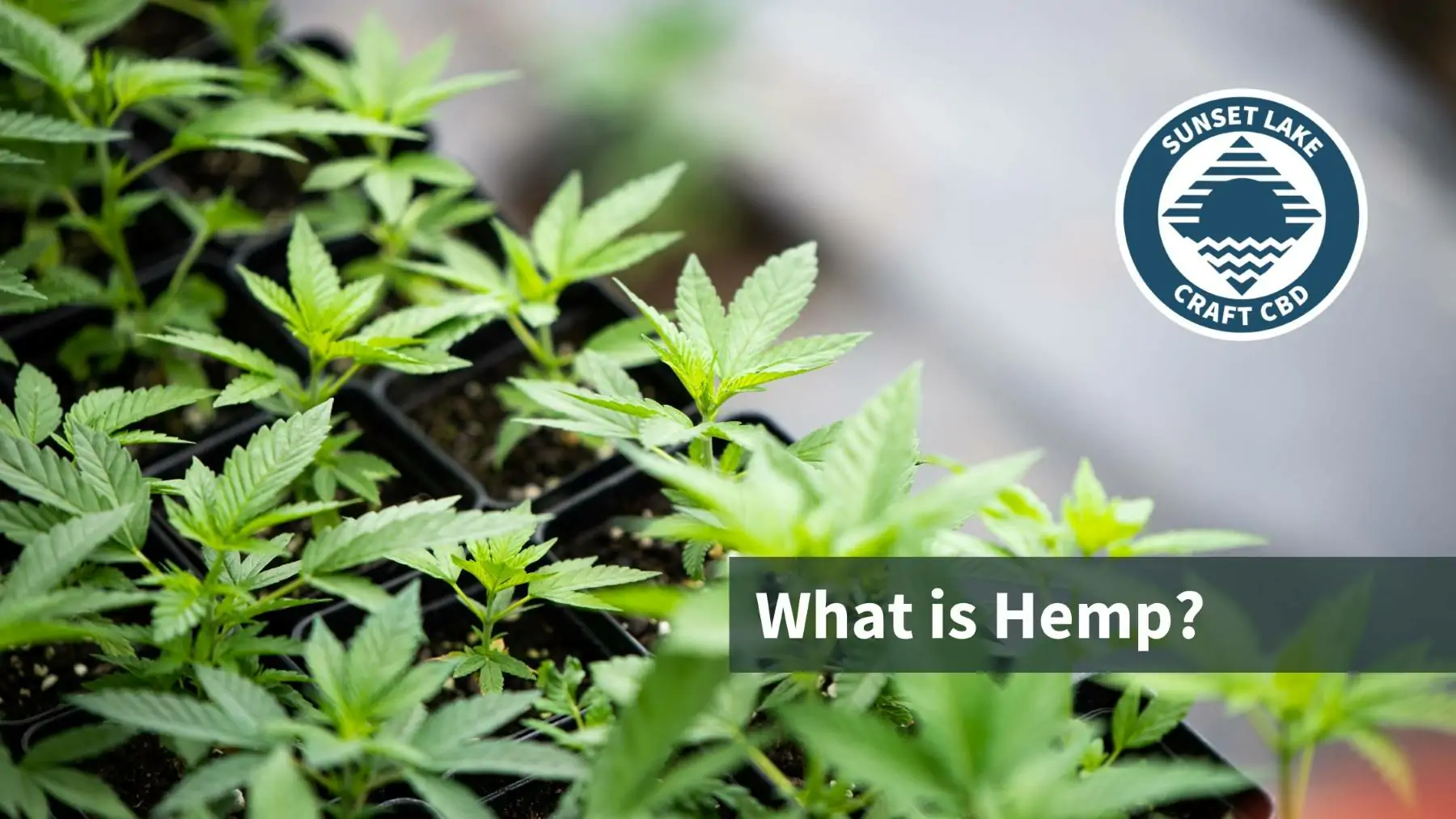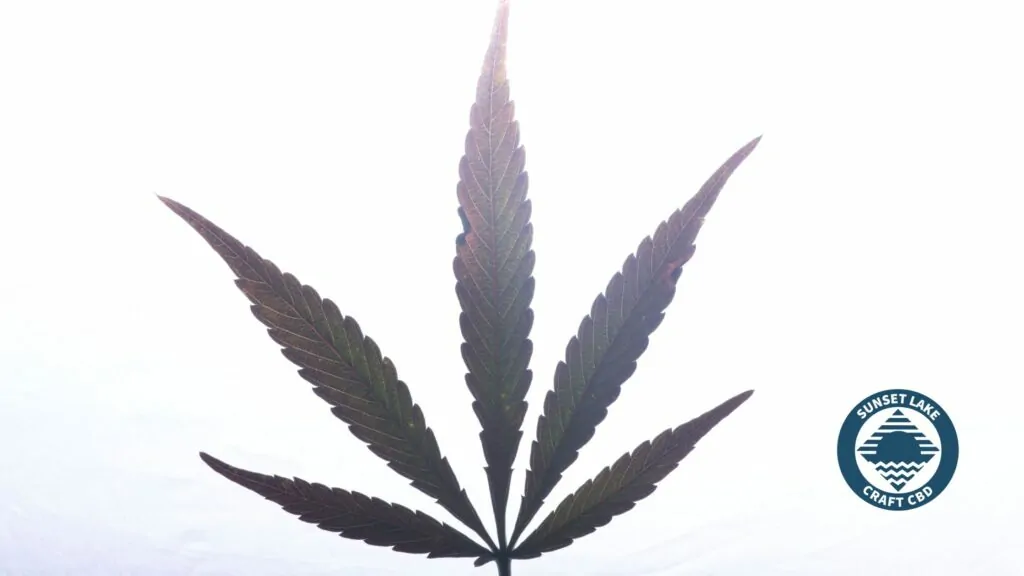No products in the cart.
What Is Hemp? Benefits, Uses, History, & More

Hemp (Cannabis Sativa L.) is an ancient plant with a rich history. Originating in Central Asia, the first recorded cultivation of hemp was in China around 2800 BCE. From there, it traveled the globe, eventually reaching the New World in the 1600s.
In this post, we’ll cover:
- The different types of hemp
- It’s significance in the 21st century
- What hemp is used for,
- And, how hemp is different than marijuana
Are Their Different Kinds Of Hemp?
There are a few different kinds of hemp. For the sake of this post, we’ll talk about two that are at the opposite ends of the spectrum: flowering hemp and grain hemp.
Flowering hemp is the type that Sunset Lake CBD cultivates for flower and CBD extract.
Farmers cultivate the other type, grain hemp, for hemp seed, fiber, and animal feed. To make it extra confusing, there is no scientific distinction between these two types of hemp. Both are considered Cannabis L. sativa. We will try to make the distinction between the two in the rest of this post.
What is Hemp in the 21st Century?
The 2018 Farm Bill defines “hemp” as a cannabis plant that contains “no more than 0.3% delta-9 THC by dry weight.”
Legal definition aside, hemp is a member of the Cannabaceae family and an annual herb that can grow up to 14 feet tall but averages around 7 feet. Grain hemp’s slender stalks are largely hollow, and their large fan-like leaves are marked with distinctive ridges.
Hemp is incredibly versatile and resilient. It can grow in a variety of climates and soil types, making it a valuable crop worldwide. Its deep root system helps to prevent soil erosion, and its rapid growth cycle allows for multiple harvests in a single year. This adaptability has made an essential crop in many cultures throughout history, and it continues to be valued today for its environmental benefits and agricultural sustainability.

What’s The Difference Between Hemp And Marijuana?
Grian hemp, flowering hemp, and marijuana are indeed the same species, but they are cultivated and used differently. The primary distinction between the three lies in their chemical compositions.
Marijuana comes from female cannabis plants that express high concentrations of THC (tetrahydrocannabinol) and THCa (tetrahydrocannabinolic acid), which are the compounds responsible for marijuana’s psychoactive effects or “high.”
On the other hand, cannabis that contains less than 0.3% delta-9 THC by dry weight is considered to be hemp. Flowering hemp will produce flowers that contain very little THC and will not give users a psychoactive effect. Grain hemp barely produces any flowers at all, as the farmers generally grow grain hemp to produce seeds instead of flowers.
What Is Hemp Used For?
The hemp plant has been utilized for a myriad of purposes throughout history, making it one of the most versatile crops known to humanity. Here are some of its primary uses:
Industrial Uses
- Fibers: Hemp fibers are strong and durable, making them ideal for a variety of industrial applications. Historically, they have been used to make rope, twine, and textiles. Today, they are also used in the production of biocomposites, which are materials made from a combination of hemp fibers and other substances. These composites are used in the automotive and construction industries for their strength and eco-friendliness.
- Paper: Hemp fiber can be processed into paper, offering a more sustainable alternative to wood pulp. Hemp paper is stronger and more durable than traditional paper, and its production requires fewer chemicals and less water.
- Construction Materials: Can be used to create sustainable building materials such as hempcrete, a mixture of hemp hurds (the woody core of the plant), and lime. Hempcrete is lightweight, strong, and has excellent insulation properties, making it a popular choice for eco-friendly construction.
Nutritional Uses
- Seeds: Hemp seeds are a great source of protein, essential amino acids, fatty acids, and vitamins. Most people consume them raw, toasted, or ground into a powder. Try putting them in your salad or a smoothie if you want to harness their health benefits.
- Oil: Hemp oil is extracted from the cold-pressed seeds and is rich in omega-3 and omega-6 fatty acids. People use this pressed oil in cooking, as a dietary supplement, and in skincare products.
Medicinal Uses
- CBD Products: One of the most popular uses of flowering hemp today is the extraction of CBD. CBD oil tinctures, capsules, and topical creams are widely available and used for various therapeutic purposes.
- Novel Cannabinoids: Advances in hemp processing have led to the creation of novel cannabinoids like delta-8 THC, delta-10 THC, and THC-O. These cannabinoids offer different psychoactive effects.
Historical Uses
- Ancient China: Hemp was first cultivated in China around 2800 BCE. It was used for making textiles, paper, and rope. The Chinese also used the seeds for food and medicine, recognizing their nutritional and therapeutic benefits.
- Ancient India: Hemp was used in traditional Ayurvedic medicine for its healing properties. It was also woven into fabrics and used to make durable ropes.
- Europe: Hemp was introduced to Europe in the early centuries AD and quickly became a vital crop. It was used to make sails and ropes for ships, contributing to the success of European exploration and trade.
- Colonial America: European settlers brought hemp to the Americas in the 1600s. It was grown extensively in the American colonies for its fiber, which was used to make textiles, ropes, and paper. Some of the founding fathers, including George Washington and Thomas Jefferson, were hemp farmers.
Environmental Benefits
- Sustainable Crop: Grows quickly and can be cultivated in a variety of climates and soils. It requires minimal pesticides and herbicides, making it an environmentally friendly crop.
- Soil Health: Hemp’s deep root system helps to prevent soil erosion and improve soil structure. It can also phytoremediation, or clean, soil by absorbing heavy metals and other contaminants.
- Carbon Sequestration: Hemp absorbs CO2 from the atmosphere as it grows, helping to reduce greenhouse gas levels. Hemp crops can sequester more carbon per acre than forests, making them an effective tool in combating climate change.
Can It Get You High?
Eating hemp will not get you high. Seeds and oil contain negligible amounts of THC, the psychoactive compound found in higher concentrations in marijuana. However, because CBD-rich flower contains trace amounts of delta-9 THC, it is conceivable that consuming a large quantity could lead to intoxication, although this is unlikely in normal usage.
The more common method of getting high from hemp involves the use of novel cannabinoids extracted and manufactured from CBD extract. Companies have found ways to transform CBD into delta-8 THC, delta-10 THC, THC-O, and other THC analogs. These novel cannabinoids exist in a federal gray area and have allowed people in certain states to get high with less legal risk.
FAQs
- What is the legal definition of hemp?
- The 2018 Farm Bill defines hemp as cannabis that contains no more than 0.3% delta-9 THC by dry weight.
- How is hemp different from marijuana?
- Hemp and marijuana are the same plant species, but hemp contains less than 0.3% delta-9 THC, while marijuana has higher THC content.
- What are the common uses of hemp?
- It is used for its fiber, seeds, and flowers. It can be made into textiles, rope, paper, and is also used in food products and CBD-rich flower.
- Can you get high from consuming hemp products?
- Generally, consuming edible seeds or hemp seed oil will not get you high. However, products with novel cannabinoids like delta-8 THC can cause intoxication.
- Why is hemp considered a superfood?
- Seeds are rich in Omega-3 fatty acids and other nutrients, making them a popular superfood in modern diets.
Updated:
May 25, 2024
